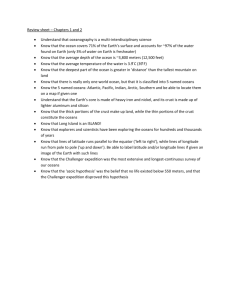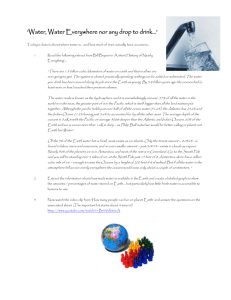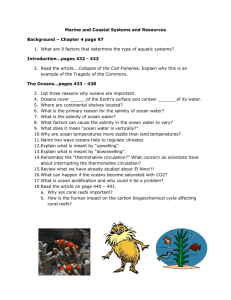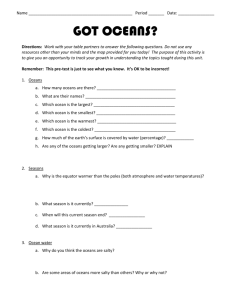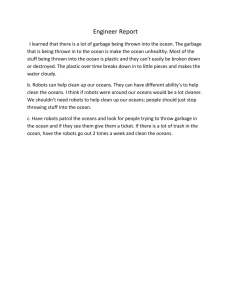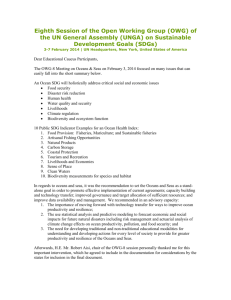Chapter 8
advertisement
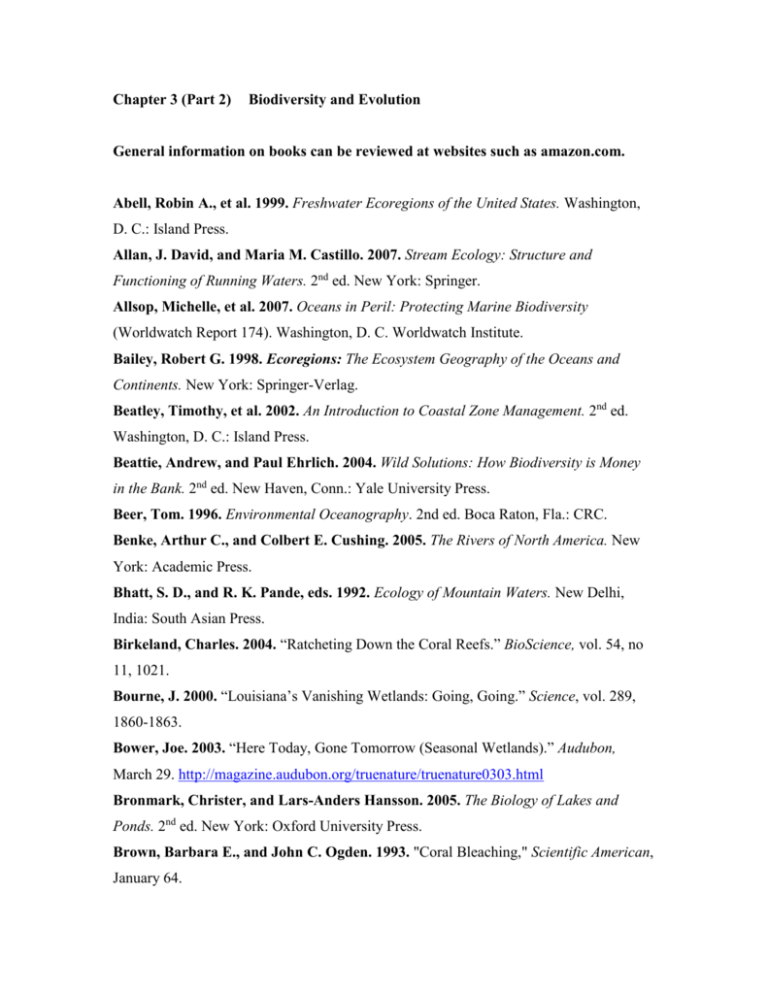
Chapter 3 (Part 2) Biodiversity and Evolution General information on books can be reviewed at websites such as amazon.com. Abell, Robin A., et al. 1999. Freshwater Ecoregions of the United States. Washington, D. C.: Island Press. Allan, J. David, and Maria M. Castillo. 2007. Stream Ecology: Structure and Functioning of Running Waters. 2nd ed. New York: Springer. Allsop, Michelle, et al. 2007. Oceans in Peril: Protecting Marine Biodiversity (Worldwatch Report 174). Washington, D. C. Worldwatch Institute. Bailey, Robert G. 1998. Ecoregions: The Ecosystem Geography of the Oceans and Continents. New York: Springer-Verlag. Beatley, Timothy, et al. 2002. An Introduction to Coastal Zone Management. 2nd ed. Washington, D. C.: Island Press. Beattie, Andrew, and Paul Ehrlich. 2004. Wild Solutions: How Biodiversity is Money in the Bank. 2nd ed. New Haven, Conn.: Yale University Press. Beer, Tom. 1996. Environmental Oceanography. 2nd ed. Boca Raton, Fla.: CRC. Benke, Arthur C., and Colbert E. Cushing. 2005. The Rivers of North America. New York: Academic Press. Bhatt, S. D., and R. K. Pande, eds. 1992. Ecology of Mountain Waters. New Delhi, India: South Asian Press. Birkeland, Charles. 2004. “Ratcheting Down the Coral Reefs.” BioScience, vol. 54, no 11, 1021. Bourne, J. 2000. “Louisiana’s Vanishing Wetlands: Going, Going.” Science, vol. 289, 1860-1863. Bower, Joe. 2003. “Here Today, Gone Tomorrow (Seasonal Wetlands).” Audubon, March 29. http://magazine.audubon.org/truenature/truenature0303.html Bronmark, Christer, and Lars-Anders Hansson. 2005. The Biology of Lakes and Ponds. 2nd ed. New York: Oxford University Press. Brown, Barbara E., and John C. Ogden. 1993. "Coral Bleaching," Scientific American, January 64. Brown, James K. M., and Mogens S. Hovmoller. 2002. “Aerial Dispersal of Pathogens on the Global and Continental Scales and Its Impact on Plant Disease.” Science, vol. 297, July 26, 537. Buchheim, Jason. 1998. Odyssey Expeditions, “Coral Bleaching.” http://www.marinebiology.org/coralbleaching.htm Campbell. Craig S., and Michael Ogden. 1999. Constructed Wetlands in the Sustainable Landscape. Hoboken, N. J.: Wiley. CORIS: NOAA’S Coral Reef Information System. http://www.coris.noaa.gov/ Couper, Alastair, ed. 1989. The Times Atlas and Encyclopedia of the Sea. Rev. ed. New York: HarperCollins. Cushing, Colbert E. and J. David Allan. 2001. Streams: Their Ecology and Life. New York: Academic Press. Daiber, Franklin C. 1986. Conservation of Tidal Marshes. New York: Van Nostrand Reinhold. Dean, Cornelia. 2001 Against the Tide: The Battle for America's Beaches. Rev. ed. New York: Columbia University Press. Dodds, Walter K. 2002. Freshwater Ecology: Concepts and Environmental Applications. New York: Academic Press. Dugan, Patrick, ed. 1993. Wetlands in Danger: A World Conservation Atlas. New York: Oxford University Press. Dyer, K. 1998. Estuaries: A Physical Introduction. 2nd ed. Hoboken, N. J.: Wiley. Earle, Sylvia. 1996. Sea Change: A Message of the Oceans. New York: Ballantine Books. Earle, Sylvia. 2001. National Geographic Atlas of the Ocean: The Deep Frontier. Washington, D. C.: National Geographic Society. Earle, Sylvia, and Henry Wolcott. 1999. Wild Ocean: America’s Parks Under the Sea. Washington, D. C.: National Geographic. Edmonson, W. T. 1991. The Uses of Ecology: Lake Washington and Beyond. Seattle: University of Washington Press. Envirolink: The Online Environmental Community: Oceans. http://www.envirolink.org/topics.html?topicsku=2002119151205&topic=Oceans&topicty pe=topic Environmental Literacy Council. http://www.enviroliteracy.org/category.php/14.html Exploratorium. Hydrosphere. http://www.exploratorium.edu/climate/hydrosphere/index.html Fisheries and Oceans Canada. http://www.dfo-mpo.gc.ca/home-accueil_e.htm Fothergill, Alastair. 2007. Planet Earth As You Have Never Seen It Before. Berkeley, Calif.: University of California Press. Freudenrich, Craig C. How Barrier Islands Work. http://www.howstuffworks.com/barrier-.htm Garrison, Tom S. 2003. Essentials of Oceanography. 4th ed. Belmont, Calif.: Brooks/Cole. Garrison, Tom S. 2006. Oceanography: An Introduction to Marine Science. 4th ed. Belmont, Calif.: Brooks/Cole. Gaston, Kevin J., et al. 2004. Biodiversity: An Introduction. 2nd ed. Cambridge, Mass: Wiley-Blackwell. Giller, Paul S., and Bjorn Malmgvist. The Biology of Rivers and Streams. New York: Oxford University Press. Goldman, C., and A. Horne. 1994. Limnology. Columbus, Ohio: McGraw-Hill. Gordon, N. T., et al. 2004. Stream Hydrology: An Introduction for Ecologists. 2nd ed. Hoboken. N. J. : Wiley. Hauer, F. Richard, and Gary A. Lamberti, eds. 2006. Methods in Stream Ecology, 2nd ed. New York: Academic Press. Hinrichsen, Don. 1997. "Coral Reefs in Crisis." BioScience, vol. 47, no. 9, 554. Hinrichsen, Don, and Stephen Olsen. 2001. Coastal Waters of the World: Trends, Threats, and Strategies. Washington, D. C.: Island Press. H. John Heinz III Center for Science, Economics, and the Environment. 2002 (With Annual Online Updates). The Nation’s Ecosystems: Measuring the Land, Waters, Rivers, and Living Resources of the United States. New York: Cambridge University Press. http://www.heinzctr.org/ecosystems/report.html Hoegh-Guldberg, O., et al. 2007. “Coral Reefs Under Rapid Climate Change and Ocean Acidification.” Science, vol. 318, 1737-1742. See http://www.eurekalert.org/pub_releases/2007-12/ci-cru121007.php Horne, Alexander, and Charles Goldman. 1994. Limnology. 2nd ed. Columbus, Ohio: McGraw-Hill. Horsman, Paul. 2005. Out of the Blue: A Journey Through the World’s Oceans. Cambridge, Mass.: MIT Press. Hulot, Nicolas, et al. 2006. One Planet: A Celebration of Biodiversity. New York: Harry N. Abrams. International Year of the Ocean. http://www.yoto98.noaa.gov/facts/resource.htm Irwin, Francis, and Janet Ranganathan. 2007. Restoring Nature ‘s Capital: An Action Agenda to Sustain Ecosystem Services. Washington, D. C.: World Resources Institute. http://www.wri.org/biodiv/pubs_description.cfm?pid=4309 Jeffries, Michael, et al. 1995. Freshwater Ecology: Principles and Applications. Hoboken, N. J.: Wiley. Kaiser, Michael J. et al. 2007. Marine Ecology: Processes, Systems, and Impacts. New York: Oxford University Press. Keddy, Paul A. 2000. Wetland Ecology: Principles and Conservation. New York: Cambridge University Press. Kusler, Jon A., et al. 1994. "Wetlands." Scientific American, January 6. Lewis, William M., Jr. 2001. Wetlands Explained: Wetland Science, Policy, and Politics in America. New York: Oxford University Press. Millennium Ecosystem Assessment. 2005. Ecosystems and Human Well-Being. Synthesis. Washington, D. C.: Island Press. http://www.millenniumassessment.org/en/Synthesis.aspx Millennium Ecosystem Assessment. 2005. Ecosystems and Human Well-Being. Vol. 1, Current State and Trends. Washington, D. C.: Island Press. Millennium Ecosystem Assessment. 2005. Ecosystems and Human Well-Being. Vol. 2, Scenarios. Washington, D. C.: Island Press. Millennium Ecosystem Assessment. 2005. Ecosystems and Human Well-Being. Vol. 3, Policy Responses. Washington, D. C.: Island Press. Millennium Ecosystem Assessment. 2005. Ecosystems and Human Well-Being. Vol. 4, Multiscale Assessments. Washington, D. C.: Island Press. Millennium Ecosystem Assessment. 2005. Ecosystems and Human Well-Being. Vol. 5, Our Human Planet: Summary for Decision Makers. Washington, D. C.: Island Press. Millennium Ecosystem Assessment. 2005. Ecosystems and Human Well-Being: Wetlands and Water Synthesis. http://www.millenniumassessment.org/documents/document.358.aspx.pdf Mitsch, W. J., ed. 2005. Wetland Creation, Restoration, and Conservation: The State of Science. New York: Elsevier. Mitsch, William J., and James G. Gosselink. 2007. Wetlands, 4th ed. Hoboken, N. J.: Wiley. MODIS (NASA). Ocean Images. http://oceancolor.gsfc.nasa.gov/ Monterey Bay Aquarium On-Line. http://www.mbayaq.org/ National Academy of Sciences. 1995. Wetlands: Characteristics and Boundaries. Washington, D. C.: National Academies Press. National Biological Information Infrastructure (NBII). http://www.nbii.gov/index.html National Oceanic and Atmospheric Administration (NOAA). http://www.noaa.gov/ National Oceanic and Atmospheric Administration (NOAA). Coral Reef Conservation Program. http://www.coris.noaa.gov/ National Oceanic and Atmospheric Administration (NOAA). Coral Reef Information System (CORIS). http://www.coris.noaa.gov/ National Oceanic and Atmospheric Administration (NOAA). Ocean. http://www.noaa.gov/ocean.html Natural Resources Defense Council (NRDC). Clean Water and Oceans. http://www.nrdc.org/water/conservation/atrisk/contents.asp Niering, William A. 1991. Wetlands of North America. Legacy Words. Oceana. Protecting and Restoring the World’s Oceans. http://www.oceana.org/ Ocean Conservancy. http://www.oceanconservancy.org/site/PageServer?pagename=home Oceanography. Ocean Habitats and Research. http://www.onr.navy.mil/focus/ocean/ Pennisi, Elizabeth. 2007. “Spawning for a Better Life: Deciphering the Riddles of Coral Reproduction.” Science, vol. 318, 1712-1717, People & Planet. Coasts and Oceans. http://www.peopleandplanet.net/doc.php?id=429&section=6 Pernetta, John. 2000. Philip’s Atlas of the Oceans. 2nd ed. New York: Sterling. Pew Oceans Commission. http://www.pewoceans.org/ Pew Oceans Commission. 2004. America’s Living Oceans: Final Report. http://www.pewoceans.org/oceans/ Pilkey, Orin H., Jr., and William J. Neal, eds. 1987. Living with the Shore. Durham, N.C.: Duke University Press. Pilkey, Orin H., Jr., et al. 1984. Coastal Design: A Guide for Builders, Planners, & Homeowners. New York: Van Nostrand Reinhold. Pimm, Stuart L. 2004. A Scientist Audits the Earth. Brunswick, N. J.: Rutgers University Press. Postel, Sandra L. 2005. "From the Headwaters to the Sea: The Critical Need to Protect Freshwater Ecosystems." Environment, vol. 47, no. 10, 8-21. Powledge, Fred. 2006. “ The Millennium Assessment.” BioScience, November, 880-886. Reefbase. A Global Information System on Coral Reefs. http://www.reefbase.org/ Reef Education Network (REN). Coral Reefs. http://www.reef.edu.au/ Sapp, Jan. 2003. What Is Natural? Coral Reef Crisis. New York: Oxford University Press. SeaWeb. http://www.seaweb.org/ Scripps Institution of Oceanography. http://www.sio.ucsd.edu/ Smith, Stephen V, et al. 2003. “Humans, Hydrology, and the Distribution of Inorganic Nutrient Loading in the Ocean.” BioScience, vol. 53, no. 3, 235. Smithsonian Institution Exhibition. Ocean Planet. http://seawifs.gsfc.nasa.gov/ocean_planet.html Spalding, Mark D., et al. 2001. World Atlas of Coral Reefs. Berkeley: University of California Press. Stevenson, Robert F., and Frank H. Talbot. 1994. Oceans. Emmaus, Pa.: Rodale. Summerhays, Soames. 2002. “Rescuing Reefs in Hot Water.” Nature Conservancy, Fall, 23. Teal, John, and Mildred Teal. 1991. Life and Death of a Salt Marsh. New York: Ballantine. Thorne-Miller, Boyce. 1999. The Living Ocean: Understanding and Protecting Marine Biodiversity. 2nd ed. Washington, D. C.: Island Press. Trujillo, Alan P., and Harold V. Thurman. 2007. Introductory Oceanography, 9th ed. Upper Saddle River, N. J.: Prentice Hall. Turner, B. L., et al., eds. 1993. The Earth as Transformed by Human Action: Global and Regional Changes in the Biosphere Over the Last 300 Years. New York: Cambridge University Press. United Nations. Atlas of the Oceans. http://www.oceansatlas.org/index.jsp United Nations Environment Programme (UNEP). World Atlas of Biodiversity. http://stort.unep-wcmc.org/imaps/gb2002/book/viewer.htm United Nations Environment Programme (UNEP). 2002. Global Environment Outlook 3. Coastal and Marine Areas. http://www.unep.org/GEO/geo3/english/313.htm United Nations Environment Programme (UNEP). 2007. Global Environment Outlook 4. Water. http://www.unep.org/geo/geo4/report/04_Water.pdf U.S. Commission on Ocean Policy. 2004. Developing a National Ocean Policy. Preliminary Report. http://oceancommission.gov/documents/welcome.html U. S. Environmental Protection Agency (EPA). Oceans, Coasts, & Estuaries. http://www.epa.gov/owowwtr1/oceans/ U. S. Environmental Protection Agency (EPA). Water. http://www.epa.gov/water/ U. S. Environmental Protection Agency (EPA). Wetlands. http://www.epa.gov/owow/wetlands/ Valiela, Ivan, et al. 2001. "Mangrove Forests: One of the World’s Threatened Major Tropical Environments." BioScience, vol. 51, no. 10, 807. van der Valk, Arnold. 2006. The Biology of Freshwater Wetlands. New York: Oxford University Press. Vileisis, Ann. 1999. Discovering the Unknown Landscape: A History of America's Wetlands. Washington, D. C.: Island Press. Wallace, David Rains. 2007. Neptune’s Ark: From Ichthyosaurs to Orcas. Berkeley, Calif.: University of California Press. Water on the Web. http://waterontheweb.org/aboutus/index.html Water on the Web. Lake Ecology Primer. http://waterontheweb.org/under/lakeecology/12_producers.html Weber, Michael L., and Judith A. Gradwohl. 1995. The Wealth of Oceans: Environment and Development on Our Ocean Planet. New York: W. W. Norton. Weber, Peter. 1993. Abandoned Seas: Reversing the Decline of the Oceans. Washington, D. C.: Worldwatch Institute. Wells, Sue, and Nick Hanna. 1992. The Greenpeace Book of Coral Reefs. New York: Sterling. Wetzel, Robert G. 2001. Limnology: Lake and River Ecosystems. 3rd ed. New York: Academic Press. Whitty, Julia. 2006. “The Fate of the Ocean.” Mother Jones, March-April, 32-48. WildWorld. Interactve maps of the worlds terrestrial and aquatic ecosystems. http://www.nationalgeographic.com/wildworld/terrestrial.html Wohl, Ellen. 2004. Disconnected Rivers: Linking Rivers to Landscapes. New Haven, Conn.: Yale University Press. Woods Hole Marine Biological Laboratory (MBL). http://www.mbl.edu/ Woods Hole Oceanographic Institution. http://www.whoi.edu/ Woods Hole Research Center. http://www.whrc.org/ Worldwatch Institute. Freshwater Ecosystems. http://www.worldwatch.org/topics/nature/freshwater/ Worldwatch Institute. Oceans. http://www.worldwatch.org/topics/nature/ocean/ World Wildlife Fund (WWF). Endangered Seas Programme. http://www.panda.org/about_wwf/what_we_do/marine/index.cfm World Wildlife Fund (WWF). The Living Planet Report. Published every two years. http://www.panda.org/news_facts/publications/living_planet_report/index.cfm World Wildlife Fund (WWF). Living Waters Programme. http://www.panda.org/about_wwf/what_we_do/freshwater/index.cfm
